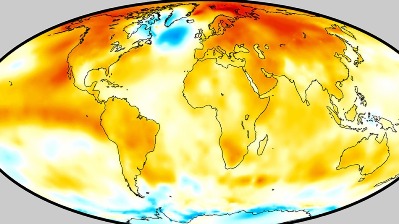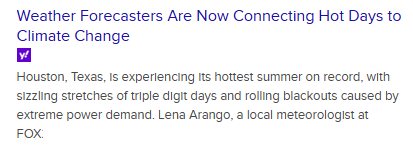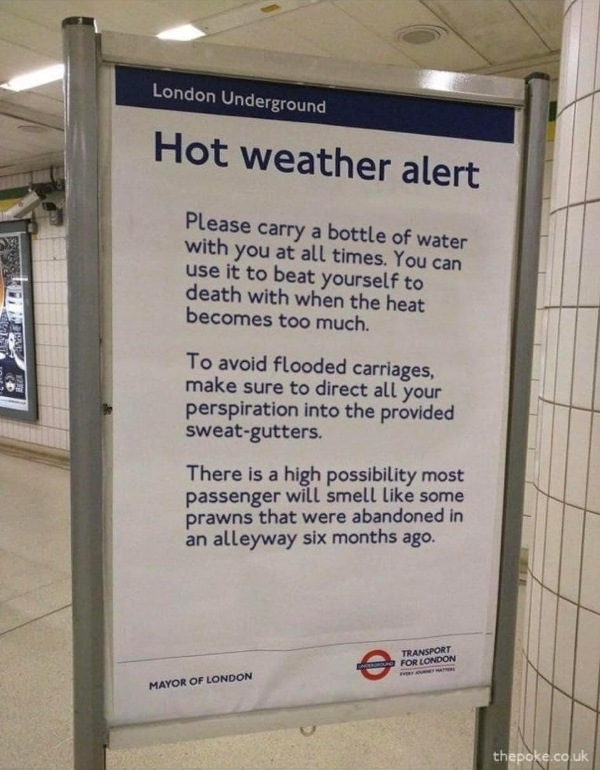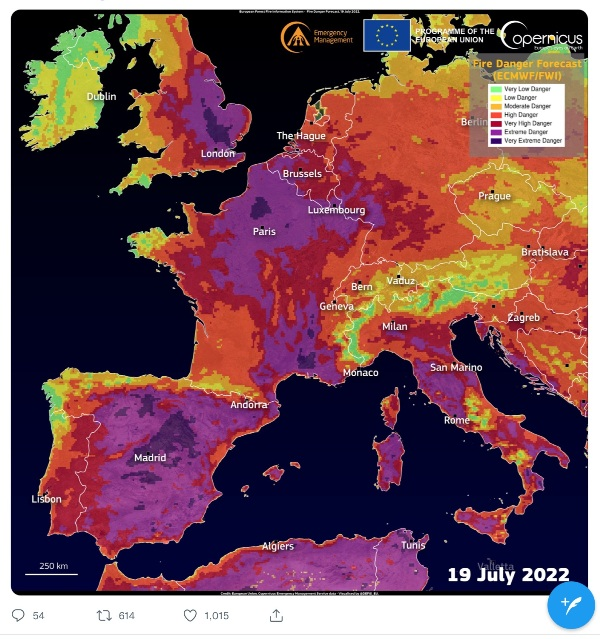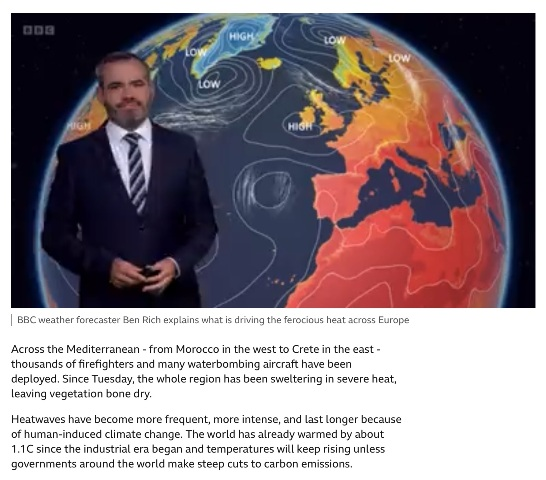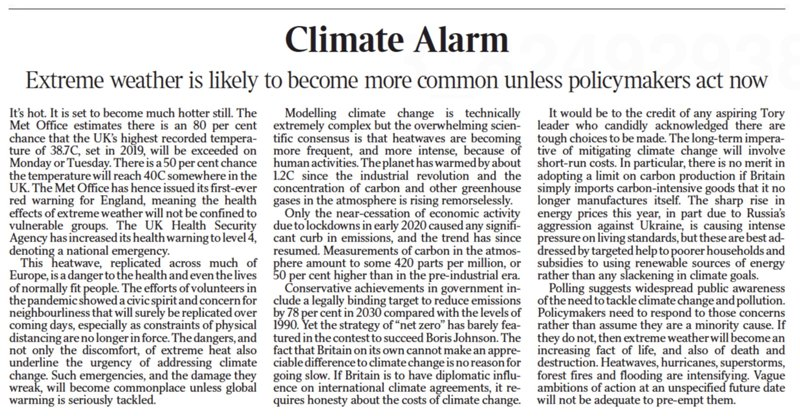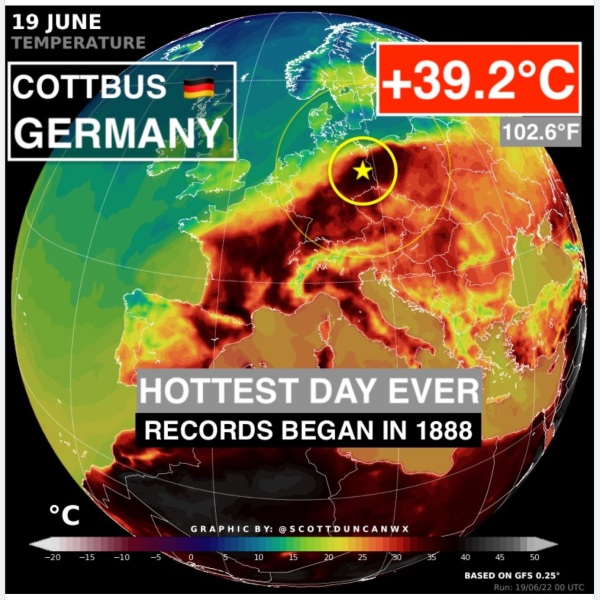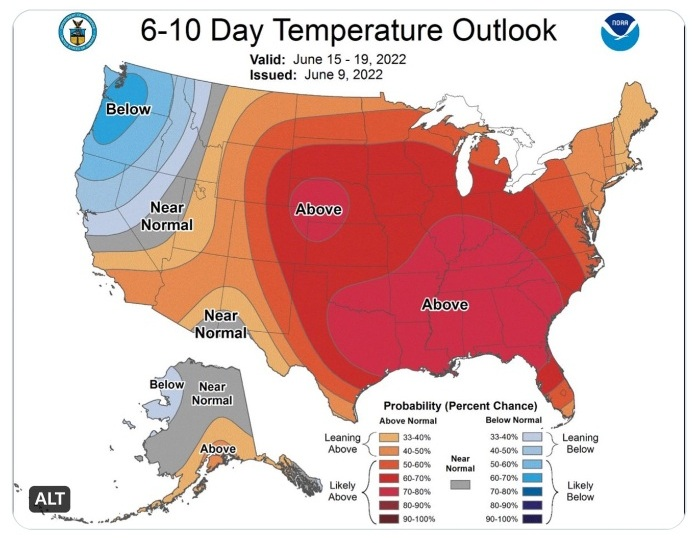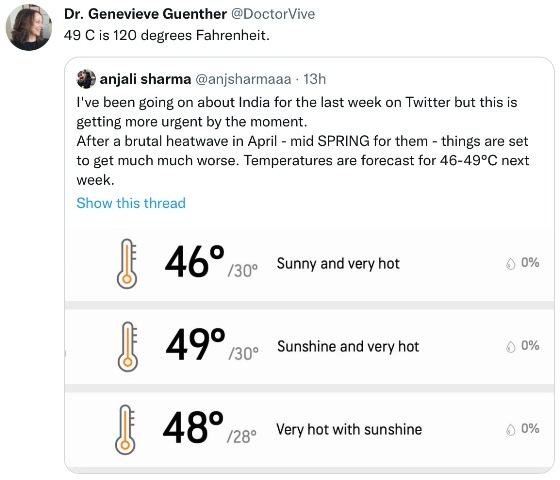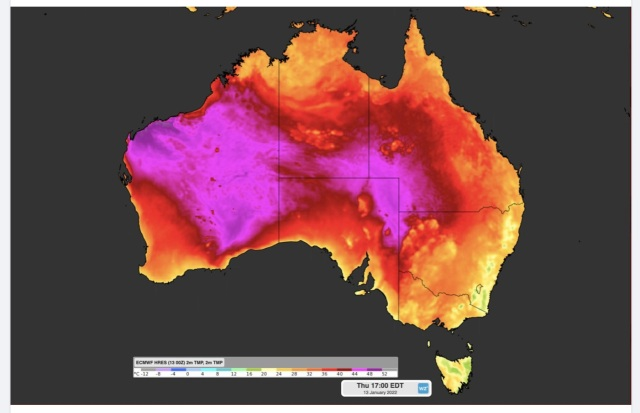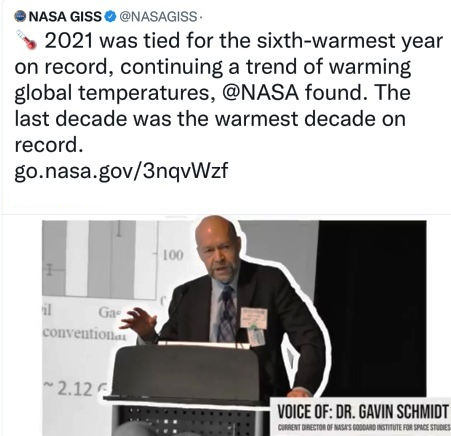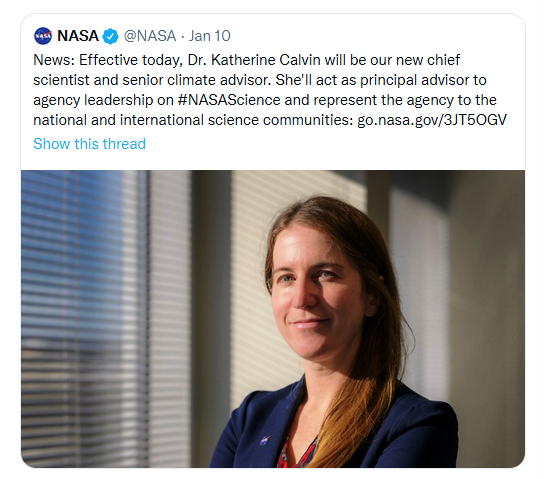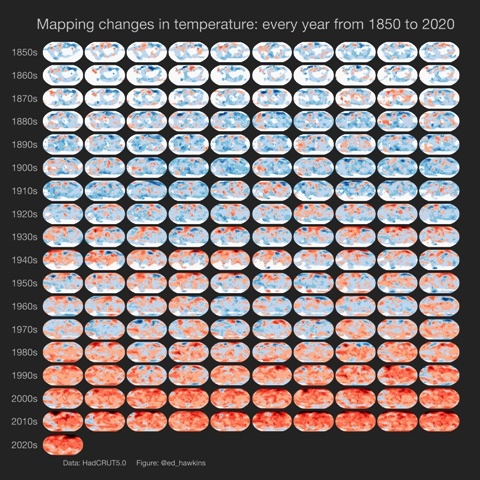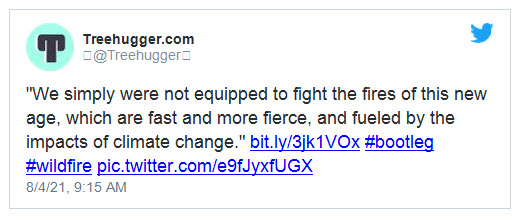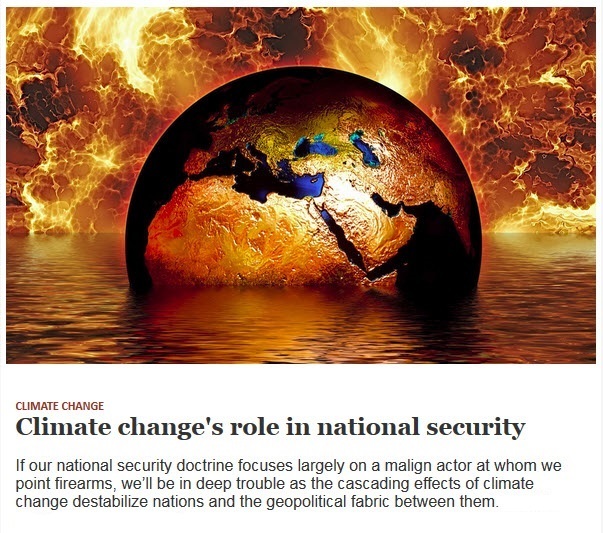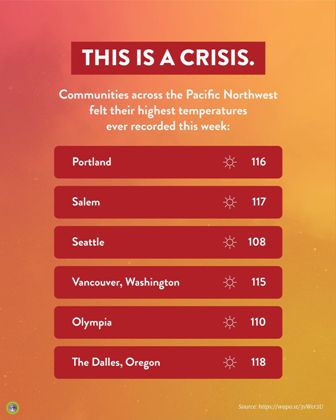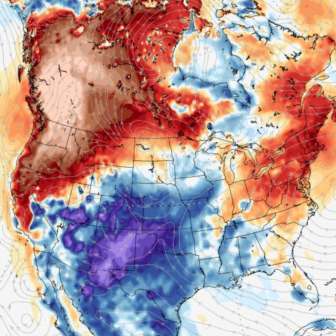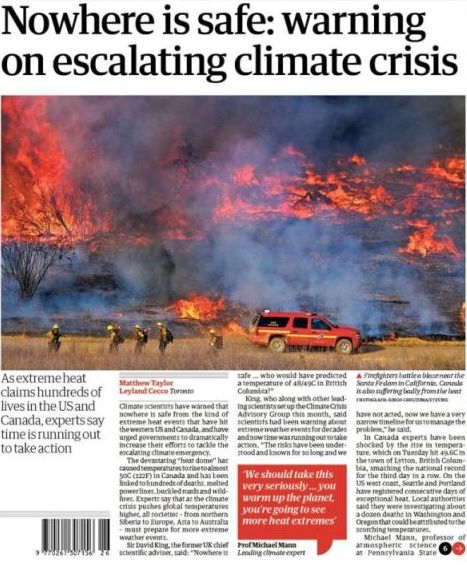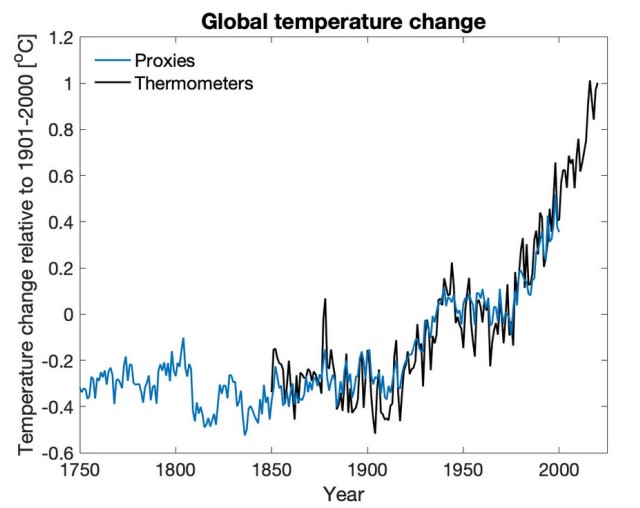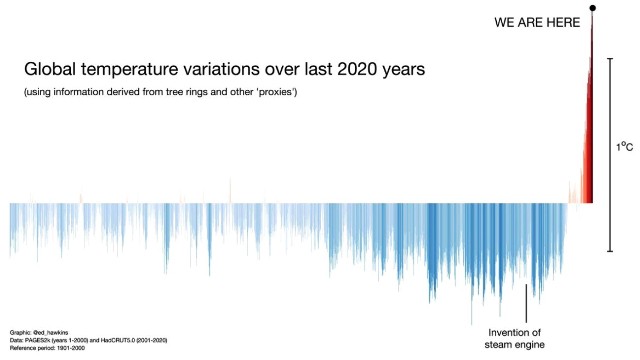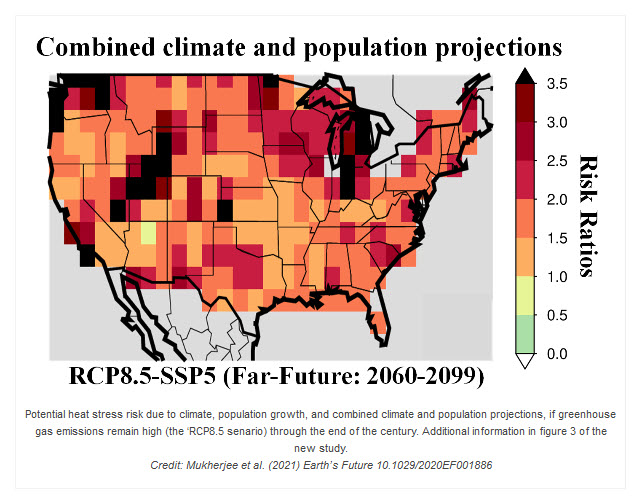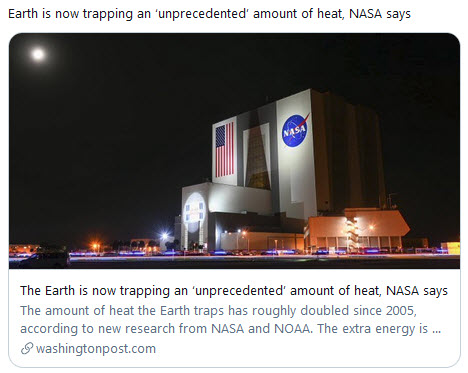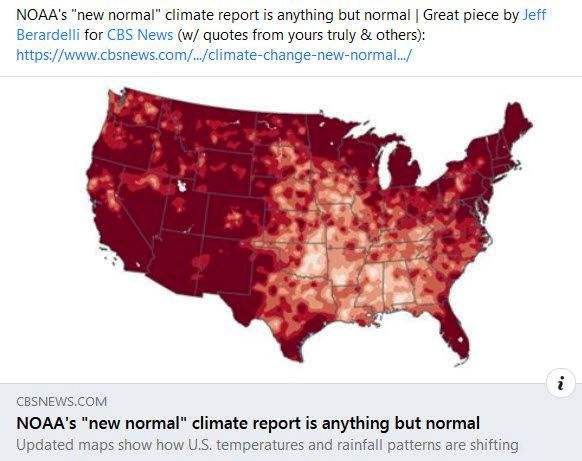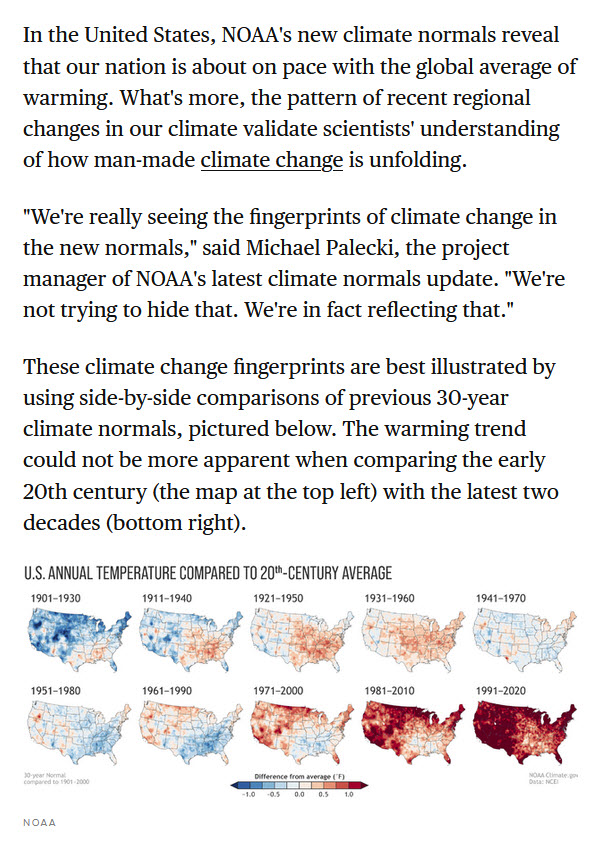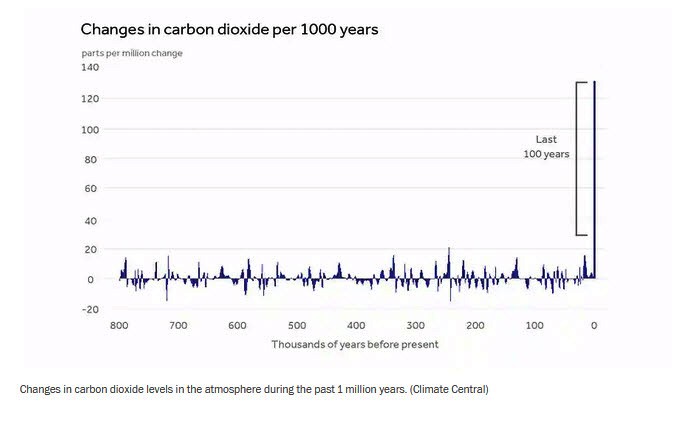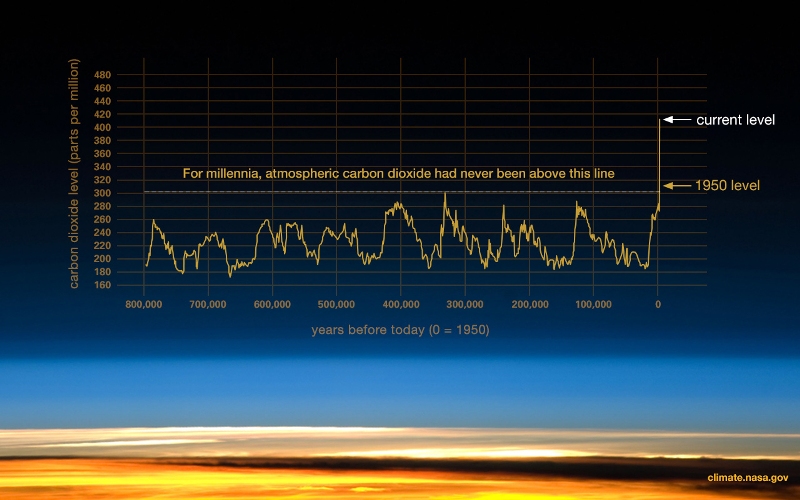Too Hot: Difference between revisions
Siterunner (talk | contribs) No edit summary |
Siterunner (talk | contribs) No edit summary |
||
| Line 26: | Line 26: | ||
: ''“We need to be prepared for the inevitable, that a quarter of the country will soon fall inside the Extreme Heat Belt with temperatures exceeding 125 degrees Fahrenheit and the results will be dire”'' | : ''“We need to be prepared for the inevitable, that a quarter of the country will soon fall inside the Extreme Heat Belt with temperatures exceeding 125 degrees Fahrenheit and the results will be dire”'' | ||
: * https://thehill.com/changing-america/sustainability/climate-change/3602580-extreme-heat-belt-will-impact-more-than-100-million-americans-study/ | :: * https://thehill.com/changing-america/sustainability/climate-change/3602580-extreme-heat-belt-will-impact-more-than-100-million-americans-study/ | ||
Revision as of 22:11, 15 August 2022
🥵 When it gets too hot
- Even your news is hot ....
- ·····································································································
2022
August 2022
True or Not: ‘Extreme heat belt’ will impact more than 100 million Americans
- “We need to be prepared for the inevitable, that a quarter of the country will soon fall inside the Extreme Heat Belt with temperatures exceeding 125 degrees Fahrenheit and the results will be dire”
··································································································
Around the world, we’re witnessing the impacts of global heating: in the past week, airport runways have melted in the UK, wildfires have torched huge swathes of Europe, and more than 100 million Americans have sweltered in dangerously high temperatures. Already this year, prolonged heatwaves and drought in many of the world’s breadbaskets have exacerbated a global food shortage that has raised the number of people living with food insecurity from 440 million to 1.6 billion.
There are many to blame for the climate crisis and its extreme weather impacts. Executives of fossil fuel companies bear the greatest responsibility. More than anything else, it has been their great deceit – their burying of climate science, funding of climate denial, and spending of billions to kill climate policy – that has prevented us from transitioning away from an economy powered by coal, oil and gas. Compromised politicians, including the entire Republican party and the Democratic coal baron Joe Manchin, deserve special condemnation, too.
In the cast of climate villains, however, another character rises to claim a special place on center stage: Wall Street.
On 12 December 2015, virtually every nation on earth adopted the Paris agreement. “Today, the American people can be proud – because this historic agreement is a tribute to American leadership,” enthused President Obama. But there were problems from the beginning. The most obvious was that the agreement was voluntary; it lacked a legally binding commitment to reduce emissions. Another major problem was that no one on Wall Street was paying attention.
Since the Paris Agreement, the six largest US banks – Chase, Citi, Wells Fargo, Bank of America, Morgan Stanley and Goldman Sachs – have provided $1.4tn in financing to the fossil fuel industry. Indeed, since that heralded day in the French capital, the world’s four largest funders of fossil fuel expansion have all been US banks. So much for “American leadership”.
Read more in The Guardian
🥵
Environmental full-cost accounting
- Measuring Full Costs: Dealing with Damage to 'The Commons'
🥵
August 2, 2022
BP sees biggest profit in 14 years
Oil/Gas Prices Soar
Energy giant sees underlying profits hit $8.45bn (£6.9bn) between April and June - more than triple the amount it made in same period last year
Short-term profit taking ..... long-term 'externality' costs adding up
Today (July 30), oil giants ExxonMobil and Chevron reported historic profits from the last three months. Exxon made $17.9 billion (not a typo) last quarter, up 273% from the same time last year, while Chevron made $11.6 billion. Exxon’s rate of income was $2,245.62 every second of every day for the past 92 days; Chevron made $1,462.11 per second.
Together, BP, Chevron, ExxonMobil, Shell, and TotalEnergies are expected to announce $60 billion in profits for the past three months. They plan to spend much of the profit not on reinvesting in their businesses, but on stock buybacks, which drives up the price of the stock. (HCR)
○
July 2022
'Oil/Gas Capital of the World'.... Say What Lone Star State?
Houston, Texas, is experiencing its hottest summer on record, with sizzling stretches of triple digit days and rolling blackouts caused by extreme power demand. Lena Arango, a local meteorologist at FOX26, wanted her viewers to understand why. “The temperatures we’re experiencing today are five times more likely [because of] climate change,” she said on a TV forecast earlier this month. “I thought that was pretty interesting.”
○
Nationally Integrated Heat Health Information System
Heat related illnesses and death are largely preventable with proper planning, education, and action. Heat.gov serves as a vital source of heat and health information for the nation to reduce the health, economic, and infrastructural impacts of extreme heat.
Heat.gov is the web portal for the National Integrated Heat Health Information System (NIHHIS).
How Hot? Lawyerly Hot
Heat Waves: Legal Adaptation to the Most Lethal Climate Disaster (So Far)
By Michael B. Gerrard
Michael B. Gerrard is Andrew Sabin Professor of Professional Practice and Faculty Director of the Sabin Center for Climate Change Law at Columbia Law School. He formerly chaired the faculty of Columbia University’s Earth Institute, and the Section of Environment, Energy and Resources of the American Bar Association
(Conclusion-Excerpt)
State legislatures should expand the warranty of habitability to require landlords to provide tenants with protection against heat as well as cold. Low-income energy assistance programs should be fully funded and should cover both the purchase of air conditioners and the electricity to run them (as they now help pay for heating oil and gas). As is now the case with military family housing, public housing in all but the coolest areas should have air conditioning. Because this action could make the housing less affordable, the government will need to step up its funding to fill the need.
Building codes should encourage ventilation, awnings, shades, and other traditional methods to lower the heat.
Governments at all levels should buy only the most efficient air conditioners to help drive the market. The federal government should progressively tighten the efficiency standards for air conditioning to help drive the technology.
To lower the urban heat island effect and reduce energy demand, states and cities should require cool roofs, green roofs, or solar panels for new buildings and reconstructed roofs where the geometry of the architecture allows it. Incentives such as tax credits should be provided to help owners retrofit existing buildings. Paved surfaces should be minimized, and where they are necessary, created with light-colored and preferably porous pavement. Cities should plant large numbers of trees on public property, and maintain them well, ideally with community assistance. Cities should also require private developments to preserve as many trees as possible, and to have extensive landscaping and vegetation, both horizontal and vertical.
Social service agencies should encourage programs to check in on vulnerable people (especially the elderly and disabled living alone) during heat waves. Heat warnings and tips should be widely announced through broadcast and social media. All-night cooling centers should be established, and their locations well-publicized. Nursing homes and assisted living facilities should be frequently checked during heat waves.
Air conditioning should be provided in the hottest prisons, jails, and other detention facilities, and at least passive cooling in the rest. Where it is still hot, inmates should be given ample cool water and allowed to take frequent showers. Contracts with private facilities should require the same precautions. The size of the incarcerated population should also be reduced, but that is straying into other areas of law.
In the occupational setting, OSHA should establish formal binding standards for heat exposure and relief, not just guidelines, and it should conduct frequent inspections to ensure compliance. For outdoor workers, precautions similar to those adopted by the United States Armed Forces and California should be required.
If all of this is done, people and communities will be much better able to cope with the extreme temperatures that are in our future.
○
LONDON (AP) — Britain shattered its record for highest temperature ever registered Tuesday (July 19), with a provisional reading of 39.1 degrees Celsius (102.4 degrees Fahrenheit) — and the national weather forecaster predicted it would get hotter still.
UK: Extreme Heat Warning
Two months ago, France experienced its hottest May on record, with record highs in some cities. Last month, France was blistered again, by a spring heat wave that also affected Spain, Italy and other countries. Then, this month, Poland and other parts of Eastern Europe suffered during a spell of extreme heat.
Now temperatures across Europe are soaring yet again, at or near triple digits from Spain to the British Isles and spreading east. Wildfires stoked by the heat are burning in many countries, and much of the continent is in the throes of a lengthy drought.
And there are still two months of summer left.
Scientists say the persistent extreme heat already this year is in keeping with a trend. Heat waves in Europe, they say, are increasing in frequency and intensity at a faster rate than almost any other part of the planet, including the Western United States. (NYT/July 18)
Heat and humidity gets dangerous to health sooner than most people realise
"It's way too late I'm afraid to stop runaway climate change,i.e. well beyond 1.5C.
- You only have to look at the picture on energy use to realise that
The Times view on dangerous heatwaves: Climate Alarm
○
EXTREME SUMMER: Summer in America is becoming hotter, longer and more dangerous
The process is “turning what for many Americans is a time of joy into stretches of extreme heat, dangerously polluted air, anxiety, and lost traditions.”
Scientists say the recent spate of severe summers is a clear change from previous generations. The average summer temperature in the past five years has been 1.7 degrees (0.94 Celsius) warmer than it was from 1971 through 2000, according to a Washington Post analysis of data from the National Oceanic and Atmospheric Administration. But some parts of the country have been much harder hit, with the West showing a 2.7 degrees (1.5 Celsius) increase.
Journal of Climate
- Sixfold Increase in Historical Northern Hemisphere Concurrent Large Heatwaves Driven by Warming and Changing Atmospheric Circulations
More global heat records are broken, from the Arctic to Japan
June heat waves set monthly and all-time high-temperature records in the U.S., Europe, Asia and the Russian Arctic...
○
June 2022
Texas Hot
- https://texasclimatenews.org/2022/06/22/extreme-summer-heat-could-rival-texas-record-setting-summer-of-2011/
- https://www.houstonchronicle.com/business/energy/article/Forecasts-show-ERCOT-may-need-reserve-power-17260753.php
Around the World Hot
In a blistering hot June around the Northern Hemisphere, in which heat records have fallen on every continent, Japan is the latest to swelter. Temperatures shot above 104 degrees (40 Celsius) for the first time on record during the month, another clear sign of the sweeping effects of human-caused climate change. (WaPo, June 26)
Europe Sizzles
······································································
"It's not going to be something you can escape."
How Extreme Heat Kills, Sickens, Strains and Ages Us
Researchers are drilling down into the ways life on a hotter planet will tax our bodies, and looking for protections that, unlike air-conditioning, don’t make the problem worse
June 14, 2022
- NASA
Hot Springtime for India
·············································································
Australia reaches global high temperatures
- ·····································································································
Ocean warmth sets record high in 2021 due to greenhouse gas emissions
- Since the late 1980s, Earth’s oceans warmed at a rate eight times faster than the preceding decades
Global Report: Fifth Warmest Year on Record
- Last seven years hottest ever recorded globally
Gavin Schmidt, who heads NASA’s temperature team, said “the long-term trend is very, very clear. And it’s because of us. And it’s not going to go away until we stop increasing the amount of carbon dioxide in the atmosphere.”
The past seven years have been the hottest in recorded history, new data shows
Global temperatures in 2021 were among the highest ever observed, with 25 countries setting new annual records, according to scientists from NASA, NOAA and Berkeley Earth
Berkeley Earth is a Berkeley, California-based independent 501 non-profit focused on land temperature data analysis for climate science. Berkeley Earth was founded in early 2010 with the goal of addressing the major concerns from outside the scientific community regarding global warming and the instrumental temperature record.
···························
December 2021
Kodiak, Alaska.
This is berserk. Kodiak, Alaska hit 65 degrees today, 20 DEGREES warmer than their previous record.
Not their average. Their record.
·······················
November
Global temperature over the last 24,000 years find warming unprecedented:
- 1. GHG concentrations;
- 2. ice-sheet retreat;
- 3. warming rate unprecedented
The study, published in Nature 10 11 2021, had three main findings:
It verified that the main drivers of climate change since the last ice age are rising greenhouse gas concentrations and the retreat of the ice sheets.
It suggests a general warming trend over the last 10,000 years, settling a decade-long debate about whether this period trended warmer or cooler in the paleoclimatology community.
The magnitude and rate warming over the last 150 years far surpasses the magnitude and rate of changes over the last 24,000 years.
······················
Earth gets hotter, deadlier during decades of climate talks
October
September
The hottest summer most Americans have ever lived through
Via Yale Climate Connections
August
Mediterranean Style Heat Setting Records
Aug. 13, 2021
Sicily — Before this week, the small Sicilian town of Floridia had a few claims to fame. The second wife of a Bourbon king was the town’s duchess. The snails that are a local delicacy are raised here. Its surrounding fields won it the greenest city in Italy prize in 2000. Its mayor is among Italy’s youngest.
But now Floridia has become known for something else, something far more ominous. It is perhaps the most blisteringly hot town in the recorded history of Europe, offering Italy and the entire Mediterranean a preview of a sweltering and potentially uninhabitable future brought on by the globe’s changing climate.
“Floridia is now the center of the world when it comes to the climate,” said Mayor Marco Carianni... a day after a nearby monitoring station registered a temperature of 119.84 degrees...
NOAA declares July 2021 the hottest month on Earth since record-keeping began
(August 13) The National Oceanic and Atmospheric Administration declared July 2021 the world’s hottest month in 142 years of records. “In this case, first place is the worst place to be,” NOAA Administrator Rick Spinrad said in a statement.
“This new record adds to the disturbing and disruptive path that climate change has set for the globe.”
Heat Emergency Brings Record Temperature and Fire to Southern Europe
- Evacuations Spread as Fires Flare Up
Greece experiences its hottest day on record this week and wildfires leave much of Southern Europe struggling to cope
More history-making fires in California
····································································································································
- ················································································································
Power outages cripple parts of the Middle East amid record heat waves and rising unrest
A team of chemists at the American University in Beirut estimated this month that Lebanon's nearly 24-hour reliance on generators is poisoning the air eight times as fast as when Beirut was operating generators on average only several hours a day. ... The brutal heat is punishing...“The heat is so bad that it hurts you. It’s hard to even describe to someone who hasn’t experienced it,” said Tahsin Mohamed, sitting in his home in the southern Iraqi town of Majer. He rolled up his long, black djellaba shirt to reveal a burn scar etched on his shin.“Imagine,” he said. “The sun did that to me.”
············································
Seven Big Warnings
The 'killer heat wave', the ‘heat dome’ signalled our new reality. Here are key issues we must address now — or pay a big price later.
···················
July 14, 2021
Via Associated Press / By Seth Borenstein
The West is going through “the trifecta of an epically dry year followed by incredible heat the last two months and now we have fires,” said University of California Merced climate and fire scientist John Abatzoglou. “It is a story of cascading impacts.”
And one of climate change, the data shows.
RECORD HEAT
In the past 30 days, the country has set 585 all-time heat records, according to the National Oceanic and Atmospheric Administration. Of those, 349 are for daily high temperatures and 236 are the warmest overnight low temperatures, which are vital for people to recover from deadly heat waves.
····················································································
The Middle East is burning. This threat could turn it into scorched earth
Two recent heat waves in the Gulf are a sign of things to come as temperatures rise due to climate change
“Business-as-usual will lead to super and ultra-extreme heat waves in the Middle East and North Africa (MENA region)”
In the space of little more than a month, Iraq, Iran and the United Arab Emirates and other countries bordering the Gulf have suffered two blistering heat waves. In back-to-back doozies, temperatures pushed past 50 degrees centigrade (122 degrees fahrenheit), once early June and again in the first days of July. Bahrain experienced its hottest June in nearly a century.
The MENA region is destined to suffer lengthy bouts of temperatures exceeding 55-56 degrees celsius during this century. In urban environments, where an increasing share of the population lives, top temperatures could spike by another 3-4 degrees due to a phenomenon called “urban heat islands.”
“The warming is getting worse and getting faster.”
Israel, like much of the Middle East, is seeing temperatures rising faster in the summer than in the winter.
Climate change may also strike a final, fatal blow to the many governments in the Arab world that are barely functioning...
North Africa Heat Wave:
Today 11 July was another scorching day with more all time record temperatures set
The Arctic Melts
Highest minimum temperature ever recorded in North America
- Highest minimum temperature ever recorded worldwide in July
Trouble in Alaska? Massive oil pipeline is threatened by thawing permafrost
In California’s interior, there’s no escape from the desperate heat: ‘Why are we even here?’
11 July 2021 was another historic day: Stovepipe Wells in the Death Valley area recorded a new world record of the highest daily average temperature on records with a staggering average temperature of 47.9C.
Death Valley temperatures just got more complicated
Rising temperatures: How to avoid heat-related illnesses and deaths - Harvard Health
From Portland, Oregon, to Vancouver, Canada, the heat during the end of June didn't just break records; it buried them
Surface temperatures in Siberia heat up to a mind-boggling 118 degrees
Warning Flashes for Europe: Climate Change Will Heat the Continent
During the heat wave of 2003, European cities cooked their people. It was the hottest August in at least half a millennium, temperatures in the high 30s squatted over much of the continent for weeks. The EU estimates that something like 80,000 people died. French President Jacques Chirac attended a somber burial service for 57 people whose bodies were never claimed.
Under any future warming scenario, a summer like 2003 will be disturbingly normal. According to EU research, at 1.5 degrees of warming, around one in every five people in the EU and U.K. will experience similar heat in any given year. At 3 degrees, that rises to more than half the population.
The heat is literally maddening. Italian researchers found a strong link between psychiatric emergencies and daily temperature. Suicides doubled in Moscow during a heat wave in 2010. In Madrid, incidents of domestic violence and women being murdered by their partners jump when the temperature goes over 34 degrees. Hot nights bring climate insomnia.
We aren’t helping ourselves. An increasing share of Europeans have made their homes in giant, heat-concentrating concrete crucibles. Cities are typically 5 to 10 degrees warmer than the surrounding countryside. If little is done to reduce global emissions, Europe’s cities could warm 6 to 10 degrees on top of that. The south will see the greatest increases. In Rome and other Mediterranean cities, the heat will become so intense that traditional architectural systems relying on natural ventilation will no longer function.
It’s bad timing for an experiment in heat endurance. Not only are millions migrating from rural areas into cement cities; Europe is also getting older and more vulnerable. Better medicine and falling birth rates mean the number of Europeans older than 65 is expected to rise by around 40 million by 2050, even as the overall population slowly declines.
The elderly are at high risk of dying from heat stress and heatstroke. Old bodies also get worn down by heat, making them more susceptible to asthma or cardiovascular and respiratory diseases. Hot days see spikes in hospitalizations for age-related complaints. Aging populations are also more likely to be diabetic; heat causes blood vessels to dilate, absorbing insulin and dragging down blood sugar.
The world has barely warmed by more than 1 degree. But in 2010, the heat killed 54,000 in Russia and Central Europe. Eight years later, during a brutal heat wave that climate change made five times more likely, 104,000 died — the most in any region of the world that year. Germany alone recorded around two-thirds of the heat-related deaths of India, the Lancet medical journal reported, despite having a population 16 times smaller.
At these lower temperature increases, deaths are concentrated in Southern and Central Europe. If warming reaches 3 degrees, 200 million Europeans, not only in the south, but many in the north and the U.K., will live at high risk of heat stress. Without rapid changes to the built environment, the EU says extreme heat could kill 95,000 Europeans every year — more than 30 times the current average rate.
Of course, there are things we can do. The immediate answer is air conditioning. But that brings its own problems. Energy use for cooling buildings in the Mediterranean — already a big source of carbon emissions — will double by 2035. In Southern Europe a new cooling poverty gap is already opening up between those who can afford to beat the heat and those who can’t.
Europe is destined to become a hot continent. Even though Northern Europeans face less steep temperature increases, they need to start thinking like southerners. Buildings designed to trap heat in winter do the same in summer. It costs four times as much to build passive cooling into an existing home than it does to fit it to a new build, according to the U.K.’s Committee on Climate Change. To cope, the streets of London, Copenhagen and Brussels will need to acquire the romantic, eyelidded feel that heavy wooden shutters bring to Rome and Marseille or the utilitarian look of roller blinds in Athens, Seville or Naples...
······································································································
America in 2090: The Impact of Extreme Heat, in Maps
·······································
The "Wet Bulb"
What's the hottest temperature the human body can endure?
Via Live Science
The 'Wet Bulb' temperature takes into account both heat and humidity
With climate change causing temperatures to rise across the globe, extreme heat is becoming more and more of a health threat. The human body is resilient, but it can only handle so much. So what is the highest temperature people can endure?
The answer is straightforward: a wet-bulb temperature of 95 degrees Fahrenheit (35 degrees Celsius), according to a 2020 study in the journal Science Advances. Wet-bulb temperature is not the same as the air temperature you might see reported by your local forecaster...
~
"Wet bulb" temperature is the temperature plus relative humidity at which water stops evaporating off a "wet" thermometer bulb. If air is sufficiently humid (saturated w/ water vapor), evaporation will no longer cool the bulb, and it gets continuously hotter.
This matters for humans, because our bodies regulate heat via evaporation: sweat glands carry heat from body to the skin surface, where it evaporates, dissipating heat into the air. As long as you stay hydrated (and take salts! salt is important), you can stay cool at high temps.
However, a key interaction here is evaporation, which is controlled in part by a) amount of energy in the sweat (how much heat it is carrying) and b) how much moisture is already in the air.
Wet bulb (is) about the absorptive capacity of air. A wet bulb temperature in the mid-80s F can, and does, kill humans.
While body temp is ~97-99 F, we maintain temp by sweating. If sweat won't evaporate, our body temp rises, continuously. And when body temp hits ~108, we're dead.
For a vulnerable person in wet bulb temp, this takes much less than an hour.
(GreenPolicy360: Weather forecasters should begin to announce a Wet Bulb / WB temperature and/or a Human Heat Index as a matter of public service)
So, what does this have to do with you? Until last ~ 40 years, wet bulb temperatures were *extremely rare* on this planet.
But that's over, now. We're already seeing multiple wet bulb temperatures per year in multiple locations. By mid-century, parts of the Southeastern U.S will see *weeks* of wet bulbs *every year.*
This is quite bad. Thousands of people will die on each of those days.
Via the Washinton Post
Wet-bulb temperature is important, climate experts say. So what is it?
At a certain threshold of heat and humidity, “it’s no longer possible to be able to sweat fast enough to prevent overheating.”
Scientists have found that Mexico and Central America, the Persian Gulf, India, Pakistan and Southeast Asia are all careening toward this threshold before the end of the century.
Hotter than the human body can handle: Pakistan city broils in world’s highest temperatures
Pakistan along the Indus Valley considered one of the places most vulnerable to climate change in the world, there are fears that Jacobabad's temperatures may increase further, or other cities may join the club.
“The Indus Valley is arguably close to being the number one spot worldwide,” says Tom Matthews, a lecturer in climate science at Loughborough University. “When you look at some of the things to worry about, from water security to extreme heat, it's really the epicentre.”
Mr. Matthews and colleagues last year analysed global weather station data and found that Jacobabad and Ras al Khaimah, north east of Dubai in the United Arab Emirates, have both temporarily crossed the deadly threshold. The milestone had been surpassed decades ahead of predictions from climate change models.
The researchers examined what are called wet bulb temperatures. These are taken from a thermometer covered in a water-soaked cloth so they take into account both heat and humidity.
Wet bulb thermometer readings are significantly lower than the more familiar dry bulb readings, which do not take humidity into account. Researchers say that at a wet bulb reading of 35C, the body can no longer cool itself by sweating and such a temperature can be fatal in a few hours, even to the fittest people.
“It approximates how warm it feels to humans because we cool via sweating,” Mr Matthews says. “We rely on that exclusively. When you use that measure, the wet bulb temperature, the two regions that stand out on earth are the shores of the Gulf and the Indus Valley in Pakistan. They are truly exceptional...”
“People are aware that the heat is getting up and up, but they are poor people. They can't go anywhere, they can't leave their places,” said Zahid Hussain, a market trader. “I myself have been thinking about shifting, but have never got around to it.”
··························································································································
Dangerous humid heat extremes occurring decades before expected
Oppressively hot summer days often evoke the expression, “it’s not the heat, it’s the humidity.” That sticky, tropical-like air combined with high temperatures is more than unpleasant — it makes extreme heat a greater health risk.
Climate models project that combinations of heat and humidity could reach deadly thresholds for anyone spending several hours outdoors by the end of the 21st century. However, new research says these extremes are already happening — decades before anticipated — due to global warming to date.
The emergence of heat and humidity too severe for human tolerance
June 2021
Via The Guardian
A “heat dome” without parallel trapped hot air over much of the states of Oregon and Washington in the United States, and southern British Columbia in Canada, in past days, shattering weather records in the usually temperate region.
In Washington and Oregon, largely liberal, climate-conscious states, efforts to combat global heating have long been popular. The Washington governor, Jay Inslee, put himself forward as the “climate candidate” during the 2020 Democratic presidential primary. He argued residents of the region would, in the absence of federal leadership, “do our part to address a global problem”.
Climate conversations have generally centered on what north-westerners could do to protect the planet or other people in places at greater risk of extreme heat. But after three days of temperatures near or above 100F (38C) in Seattle – a city where residents often describe the sixth month as “June-uary”, as temperatures rarely reach 80F (27C) – they’re increasingly concerned about themselves.
“It felt like we’d set our Earth on fire,” said Summer Stinson, a 49-year-old resident of Seattle...
Temperatures in tiny Lytton, British Columbia, hit 49.6C (121.3F) and set a Canadian all-time record, days before a wildfire tore through the town. Roads buckled under the heat in Washington and Oregon. Heat and heavy air conditioner use knocked out power for tens of thousands. The dead, thought to number in the hundreds, are not yet counted.
Ron Merkord, CalTech: Lytton, British Columbia, Canada... Named in 1858 for a novelist named Edward Bulwer-Lytton. Two days ago, it set Canada's all time temp record of 121.3F. Yesterday, it hit 121.6F. Today, it burned to the ground. Bulwer-Lytton, a contemporary of Charles Dickens, is responsible for the saying "The pen is mightier than the sword". He is also the writer responsible for the beginning novel line called the worst ever written -- "It was a dark and stormy night..."
In Lytton today, it was indeed a dark and stormy night.
Lytton's municipal website boasts: “Lytton is the ideal location for nature lovers to connect with incredible natural beauty and fresh air freedom.”
Michael Mann, director of the Earth System Science Center at Pennsylvania State University, said this week’s unexpectedly fierce heat at Lytton and elsewhere should prompt climatologists to consider additional impacts of human activity.
“We should take this event very seriously,” he wrote in an email. “You warm up the planet, you’re going to see an increased incidence of heat extremes. Climate models capture this effect very well and predict large increases in heat extremes. But there is something else going on with this heatwave, and indeed, with many of the very persistent weather extremes we’ve seen in recent years in the US, Europe, Asia and elsewhere, where the models aren’t quite capturing the impact of climate change.”
○
Via Climate.gov
Astounding heat obliterates all-time records across the Pacific Northwest and Western Canada
From Portland, Oregon, to Vancouver, Canada, the heat during the end of June didn't just break records; it buried them. Learn more in this Event Tracker post.
Devastating News: Climate Change Impacts to Hit Sooner than Predicted
Climate change will fundamentally reshape life on Earth in the coming decades, even if humans can tame planet-warming greenhouse gas emissions
Landmark report from the UN's climate science advisors obtained by AFP
Climate change threats to life on Earth are systemic, interconnected and on a scale unprecedented in human history
Earth is now trapping an ‘unprecedented’ amount of heat, NASA says
New research shows that the amount of heat the planet traps has roughly doubled since 2005, contributing to more rapidly warming oceans, air and land
The amount of heat Earth traps has roughly doubled since 2005, contributing to more rapidly warming oceans, air and land, according to new research from NASA and the National Oceanic and Atmospheric Administration (NOAA).
“The magnitude of the increase is unprecedented,” said Norman Loeb, a NASA scientist and lead author of the study, which was published this week in the journal Geophysical Research Letters. “The Earth is warming faster than expected.”
Using satellite data, researchers measured what is known as Earth’s energy imbalance — the difference between how much energy the planet absorbs from the sun, and how much it’s able to shed, or radiate back out into space.
When there is a positive imbalance — Earth absorbing more heat than it is losing — it is a first step toward global warming, said Stuart Evans, a climate scientist at the University at Buffalo. “It’s a sign the Earth is gaining energy.”
·························································
From Clearwater, Florida, May 2021
GreenPolicy360 Siterunner/SJS:
Trendlines, we are looking at trendlines today. Data, the data changing as time passes. We need to step back and have perspective. We need to look closely, to 'drill down' and see with detail. Measure-to-Manage NASA says, science advises, GreenPolicy360 recommends as a guide.
GreenPolicy360 believes in personal responsibility to manage wisely. We are planet citizens and earth is in human hands. Together we are guiding our planet home into the future. We are delivering a legacy to future generations.
Join planet citizens who are monitoring our Earth's 'Vital Signs'.
One of GreenPolicy360's great concerns is climate change, as all our readers and sharers know. A recent study of a 'new normal' caught our attention today, a global study and national breakout of data changing over time. And as we are looking at this 'new normal' data, a century of temperatures, we cannot help but think what will happen if the temperature increases continue, a trendline into the future, up and up into the 'unliveable... uninhabitable' temperatures range. 'Cooling technology' will be required and being outdoors will be limited...
Let's look more closely, a recent news 'wrap up' from a science reporter for the Associated Press.
Look .... recognize the threats. Act planet citizens, act ....
- Via the Washington Post
- Unprecedented Heatwave in the U.S. Pacific Northwest
- June 29, 2021
○
Record heat bakes Middle East as temperatures top 125 degrees
It has been called ‘the harshest heat wave in history for this time of the year’
June 9, 2021
Via the Boston Globe
Ninety degree days occurring earlier and more often. A rising toll of health effects
What does this say about climate change?
June 7, 2021
Via the Associated Press
Billions projected to suffer nearly unlivable heat in 2070
By Seth Borenstein
May 4, 2020
(AP) — In just 50 years, 2 billion to 3.5 billion people, mostly the poor who can’t afford air conditioning, will be living in a climate that historically has been too hot to handle, a new study said.
With every 1.8 degree (1 degree Celsius) increase in global average annual temperature from man-made climate change, about a billion or so people will end up in areas too warm day-in, day-out to be habitable without cooling technology, according to ecologist Marten Scheffer of Wageningen University in the Netherlands.
'How many people will end up at risk depends on how much heat-trapping carbon dioxide emissions are reduced and how fast the world population grows.
Under the worst-case scenarios for population growth and for carbon pollution — which many climate scientists say is looking less likely these days — the study in Monday’s journal Proceedings of the National Academy of Sciences predicts about 3.5 billion people will live in extremely hot areas. That’s a third of the projected 2070 population.
············································································································································
GreenPolicy360 / Reporting from our terrestrial home base, Clearwater, Florida, USA:
As just one of multiple examples of what's coming with climate change and global warming, life in Florida, USA is going to be a quite a different experience in the not too distant future. Semi-tropical will become tropical. Then there's the water... not to cool off, but to deal with the consequences of heat...
Florida 13,576 km coastline is at the frontlines of global sea-level rise. Florida is, as few realize is also 'on top of water', situated on a peninsula of 'karst', an ancient seabed of porous limestone. Above the underground water exchange of fresh-and-seawater is a political brew. Florida today, unfortunately, has become chock full of climate-change denying politicos. The state's former governor, now a US Senator, denies climate change is a serious problem, closing his eyes and ears to policy preparation and action as he was reported forbidding state government officials from even using the term 'climate change' .... Florida's following governor, fortunately, is not as extreme in his views and signed a first-ever piece of legislation to establish a state climate-related resiliency program. So there... as of May 2021, signs of environmental protection and progress in the so-called "Sunshine State".
GreenPolicy360 will continue to do what we can to push Florida to become forward-looking. Perhaps a quick look at sea-level rise would be a place to start the new "Too Hot" GreenPolicy360 page.
-- SJS / May 13, 2021
May 2021
Miami gets a "Chief Heat Officer"
by Craig Pittman / Via the Washington Post
Jane Gilbert, the city’s new chief heat officer, says she will put together a task force of experts to address the problem
Last June, Miami reported its hottest temperatures on record. The daytime sun was brutal and there was little respite even at night. Dozens of heat-related deaths were reported that year.
As the Earth warms, the city by the ocean says its heat problem is poised to become even deadlier.
Miami-Dade County Mayor Daniella Levine Cava (D) recently announced the county was creating a first-of-its-kind position — chief heat officer.
“We know extreme heat does not impact people equally — poorer communities and Black and Hispanic people bear the brunt of the public health impacts,” the mayor said in a statement. A chief heat officer will “coordinate our efforts to protect people from heat and save lives.”
Q: But heat is such a fact of life in Miami. What makes that deserving of a chief officer?
A: Miami knows heat — we’re hot and humid a good part of the year. A heat index of 105 degrees is about when you’ve hit dangerous levels, when people could really suffer from heatstroke.
We currently have an average of seven days where we get over that heat index for a couple of hours. By mid-century, we’re going to have 88 of those days — that’s more than 10 times as many days....
Q: How can you answer someone who challenges the existence of climate change?
A: We don’t have many of them in Miami-Dade County.
I’ve felt the change in the heat in the 26 years I’ve been here. It’s hard to argue that heat can’t be a risk when you’ve seen people die. It’s the number one climate- and weather-related killer in the United States.
Read Craig's Full Interview with Jane Gilbert
··································································
NOAA's "new normal" climate report is anything but normal
By Jeff Berardelli
May 8, 2021 / 7:11 AM / CBS News
It doesn't take a climate scientist to see the changes that have occurred. In the maps below, using NOAA data, Climate Central illustrates the warmer temperatures the U.S. has experienced. When comparing the latest "normals" to what used to be normal a century ago, the difference is clear — seen in red from coast to coast...
Some climate scientists, like Michael Mann of Penn State, don't love the system of reporting new normals. As he told The Associated Press, Mann prefers using a constant baseline because updating what is normal for present-day conditions obscures the long-term warming trend and makes the warming due to climate change seem less significant. "Adjusting normal every 10 years perverts the meaning of 'normal' and 'normalizes' away climate change."
US Climate Normals
The U.S. Climate Normals are a large suite of data products that provide information about typical climate conditions for thousands of locations across the United States. Normals act both as a ruler to compare today’s weather and tomorrow’s forecast, and as a predictor of conditions in the near future. The official normals are calculated for a uniform 30 year period, and consist of annual/seasonal, monthly, daily, and hourly averages and statistics of temperature, precipitation, and other climatological variables from almost 15,000 U.S. weather stations.
National Centers for Environmental Information (NCEI) generates the official U.S. normals every 10 years in keeping with the needs of our user community and the requirements of the World Meteorological Organization (WMO) and National Weather Service (NWS). The 1991–2020 U.S. Climate Normals are the latest in a series of decadal normals first produced in the 1950s. These data allow travelers to pack the right clothes, farmers to plant the best crop varieties, and utilities to plan for seasonal energy usage. Many other important economic decisions that are made beyond the predictive range of standard weather forecasts are either based on or influenced by climate normals.
🌎
Future of the Human Climate Niche
Proceedings of the National Academy of Sciences of the U.S.
May 26, 2020
Significance
We show that for thousands of years, humans have concentrated in a surprisingly narrow subset of Earth’s available climates, characterized by mean annual temperatures around ∼13 °C. This distribution likely reflects a human temperature niche related to fundamental constraints. We demonstrate that depending on scenarios of population growth and warming, over the coming 50 y, 1 to 3 billion people are projected to be left outside the climate conditions that have served humanity well over the past 6,000 y. Absent climate mitigation or migration, a substantial part of humanity will be exposed to mean annual temperatures warmer than nearly anywhere today.
Abstract
All species have an environmental niche, and despite technological advances, humans are unlikely to be an exception. Here, we demonstrate that for millennia, human populations have resided in the same narrow part of the climatic envelope available on the globe, characterized by a major mode around ∼11 °C to 15 °C mean annual temperature (MAT). Supporting the fundamental nature of this temperature niche, current production of crops and livestock is largely limited to the same conditions, and the same optimum has been found for agricultural and nonagricultural economic output of countries through analyses of year-to-year variation. We show that in a business-as-usual climate change scenario, the geographical position of this temperature niche is projected to shift more over the coming 50 y than it has moved since 6000 BP. Populations will not simply track the shifting climate, as adaptation in situ may address some of the challenges, and many other factors affect decisions to migrate. Nevertheless, in the absence of migration, one third of the global population is projected to experience a MAT >29 °C currently found in only 0.8% of the Earth’s land surface, mostly concentrated in the Sahara. As the potentially most affected regions are among the poorest in the world, where adaptive capacity is low, enhancing human development in those areas should be a priority alongside climate mitigation.
Heat Stress (HS) in Earth's Future
2020
2020 Tied for Warmest Year on Record, NASA Analysis Shows
Climate 2020: How Excess Heat is Expressed on Earth
Fastest Warming Cities and States in the U.S.
Urban Heat is Hot
Spend time in a city in summer and you can feel the urban heat rising from the pavement and radiating from buildings. Cities are generally hotter than surrounding rural areas, but even within cities, some residential neighborhoods get dangerously warmer than others just a few miles away.
Within these “micro-urban heat islands,” communities can experience heat wave conditions well before officials declare a heat emergency.
Earth-observing satellites and population data map these hot spots, often on projects with NASA. Satellites like the Landsat program have become crucial for pinpointing urban risks so cities can prepare for and respond to extreme heat, a top weather-related killer...
····························································································································
- Chart the 'Big Picture': The Keeling Curve
- Keeling's Curve has been called one of the most important scientific works of the 20th century
🌎
Year by Year, Measure and Monitor CO2 in the Atmosphere
🌎
🌎
Let's look more closely.
Let's look at a recent feature news 'wrap up' from a science reporter for the Associated Press.
Here, look....
Pay attention, recognize the threats, act planet citizens, act ....
Billions projected to suffer nearly unlivable heat in 2070
By Seth Borenstein
May 4, 2020
(AP) — In just 50 years, 2 billion to 3.5 billion people, mostly the poor who can’t afford air conditioning, will be living in a climate that historically has been too hot to handle, a new study said.
With every 1.8 degree (1 degree Celsius) increase in global average annual temperature from man-made climate change, about a billion or so people will end up in areas too warm day-in, day-out to be habitable without cooling technology, according to ecologist Marten Scheffer of Wageningen University in the Netherlands, co-author of the study.
'How many people will end up at risk depends on how much heat-trapping carbon dioxide emissions are reduced and how fast the world population grows.
Under the worst-case scenarios for population growth and for carbon pollution — which many climate scientists say is looking less likely these days — the study in Monday’s journal Proceedings of the National Academy of Sciences predicts about 3.5 billion people will live in extremely hot areas. That’s a third of the projected 2070 population.
Future of the Human Climate Niche
Proceedings of the National Academy of Sciences of the U.S.
May 26, 2020
Significance
We show that for thousands of years, humans have concentrated in a surprisingly narrow subset of Earth’s available climates, characterized by mean annual temperatures around ∼13 °C. This distribution likely reflects a human temperature niche related to fundamental constraints. We demonstrate that depending on scenarios of population growth and warming, over the coming 50 y, 1 to 3 billion people are projected to be left outside the climate conditions that have served humanity well over the past 6,000 y. Absent climate mitigation or migration, a substantial part of humanity will be exposed to mean annual temperatures warmer than nearly anywhere today.
Abstract
All species have an environmental niche, and despite technological advances, humans are unlikely to be an exception.
Here, we demonstrate that for millennia, human populations have resided in the same narrow part of the climatic envelope available on the globe, characterized by a major mode around ∼11 °C to 15 °C mean annual temperature (MAT). Supporting the fundamental nature of this temperature niche, current production of crops and livestock is largely limited to the same conditions, and the same optimum has been found for agricultural and nonagricultural economic output of countries through analyses of year-to-year variation. We show that in a business-as-usual climate change scenario, the geographical position of this temperature niche is projected to shift more over the coming 50 y than it has moved since 6000 BP.
Populations will not simply track the shifting climate, as adaptation in situ may address some of the challenges, and many other factors affect decisions to migrate.
GreenPolicy360: Speaking of Climate-induced migration.... it will be an increasingly serious strategic demand...
Climate migration -- https://www.greenpolicy360.net/w/Climate_migration
143 Million People May Soon Become Climate Migrants
Climate change will drive human migration more than other events, a new report warns. But the worst impacts can be avoided.
National Geographic / World Bank / March 2018
Climate change will transform more than 143 million people into “climate migrants” (#ClimateMigration) escaping crop failure, water scarcity, and sea-level rise, a new World Bank report concludes.
Most of this population shift will take place in Sub-Saharan Africa, South Asia, and Latin America—three “hot spots” that represent 55 percent of the developing world’s populations.
... One third of the global population is projected to experience a MAT >29 °C currently found in only 0.8% of the Earth’s land surface, mostly concentrated in the Sahara. As the potentially most affected regions are among the poorest in the world, where adaptive capacity is low, enhancing human development in those areas should be a priority alongside climate mitigation.
🥵
- Anthropocene
- Air Quality
- Air Pollution
- Agriculture
- Alternative Agriculture
- Antarctica
- Arctic
- Asia
- Atmospheric Science
- Citizen Science
- City Governments
- Climate Change
- Climate Migration
- Climate Policy
- County Governments
- Desertification
- Digital Citizen
- Earth Imaging
- Earth Observations
- Earth360
- Earth Science
- Earth Science from Space
- Earth System Science
- Ecology Studies
- Eco-nomics
- Economic Justice
- Education
- Energy
- Environmental Full-cost Accounting
- Environmental Security, National Security
- Environmental Laws
- Environmental Protection
- Environmental Security
- ESA
- European Union
- Externalities
- Extinction
- Florida
- Food
- Forests
- Fossil Fuels
- Greenland
- Global Security
- Global Warming
- Green Networking
- Green Best Practices
- Green Politics
- Health
- INDC
- India
- Maps
- Money in Politics
- NASA
- NOAA
- Natural Resources
- Networking
- New Definitions of National Security
- New Economy
- New Space
- Oceans
- Ocean Science
- Online Education
- Planet Citizen
- Planet Citizens
- Planet Citizens, Planet Scientists
- Rainforest
- Renewable Energy
- Resilience
- Russian Federation
- Sea-level Rise
- Sea-Level Rise & Mitigation
- Social Justice
- Soil
- Solar Energy
- Strategic Demands
- Sustainability Policies
- Threat Multiplier
- United Nations
- US
- US Environmental Protection Agency
- Water Quality
- Whole Earth
- Wind Energy
- World Bank
- World Wide Web
- Youth

